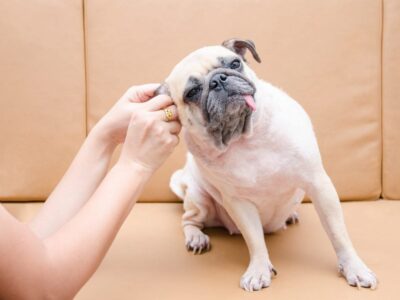Cleaning a dog’s ears is essential to canine grooming and can help prevent ear infections. You will need a few supplies to clean your dog’s ears, including ear cleaning solution, cotton balls or pads, and possibly ear wipes or a cleaning tool. If you belong to this class of pet enthusiasts who care about their pet’s wellbeing, then we teach you how to clean dog’s ears.
Start by gently holding your dog’s ear flap and apply a few drops of ear-cleaning solution to the ear canal. Massage the base of the ear to help the solution work its way into the ear and loosen any dirt or wax. Then, use a cotton ball or pad to gently wipe the inside of the ear, being careful not to go too deep into the ear canal.
If your dog has a lot of wax buildup or debris, you may need to use ear wipes, or a cleaning tool designed to remove ear wax. Ensure to dry your dog’s ears thoroughly after cleaning to prevent moisture from accumulating in the ear canal.
Always be gentle and avoid cleaning your dog’s ears too frequently, as over-cleaning can cause irritation and discomfort.
How to clean dog’s ears

Cleaning a dog’s ears is vital to maintaining its overall health and hygiene. Be gentle and cautious when cleaning your dog’s ears, as the ear canal is delicate and can be easily damaged. Here’s how to clean your dog’s ears:
First, gather your supplies. You’ll need an ear-cleaning solution specifically designed for dogs, cotton balls or pads, and possibly a towel or small bowl of warm water. Do not use alcohol, hydrogen peroxide, or any other human ear-cleaning solution, as these can harm dogs.
Next, make sure your dog is comfortable and relaxed. You may need to have someone help hold your dog still if they are particularly wiggly or anxious. If your dog has long hair, you may need to gently lift the hair around the ear to get a better view of the ear canal.
Apply the ear cleaning solution to a cotton ball or pad, and gently wipe the inside and outside of the ear. Be sure to avoid inserting anything into the ear canal, which can damage the ear drum and cause discomfort. If your dog has a lot of ear wax or debris, you may need to gently clean the area with a cotton ball or pad moistened with warm water.
Once you have finished cleaning the ear, use a dry cotton ball or pad to gently blot the ear to remove any excess solution or moisture. You can also gently massage the base of the ear to help disperse the cleaning solution and stimulate circulation.
It’s not recommended to clean your dog’s ears once a week or as needed. Suppose you notice any unusual discharge, redness, swelling, or a foul smell coming from your dog’s ears. Or if your dog is shaking their head or scratching their ears excessively, it’s essential to consult with a veterinarian as these could be signs of an ear infection or other issues.
Why is it important to clean a dog’s ears?
Cleaning a dog’s ears is vital to maintaining its overall health and well-being. There are several reasons why cleaning a dog’s ears is essential.
First, ear infections are common in dogs and can be caused by various factors, including wax buildup, allergies, or foreign objects in the ear. Cleaning your dog’s ears regularly can help prevent ear infections by removing excess wax and dirt that can harbor bacteria or yeast.
In addition, dirt, wax, and debris can accumulate in a dog’s ears over time, which can cause hearing loss or difficulty hearing. Cleaning your dog’s ears regularly can help improve their hearing by removing any blockages that may be present. This is especially important if your dog is an active breed that relies on its sense of hearing to navigate its environment or perform specific tasks.
Cleaning your dog’s ears can also help alleviate discomfort or pain. Dogs with dirty or infected ears can be uncomfortable or in pain and cleaning their ears can help improve their overall quality of life.
Finally, regular ear cleaning allows you to closely examine your dog‘s ears and identify potential problems early on. This can help prevent serious health issues from developing and allow for prompt treatment. Cleaning your dog’s ears regularly can catch any issues before they become more severe and help your dog live a happier, healthier life.
How often should I clean my dog’s ears?
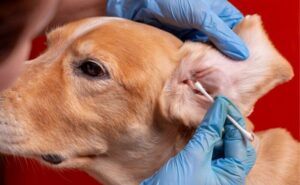
It is a good idea to check your dog’s ears at least once a week for any signs of irritation or infection. This includes redness, swelling, discharge, or a bad smell. If you notice these signs, you should bring your dog to the vet for a professional examination and treatment.
If your dog has healthy ears and is not prone to ear infections, you may only need to clean its ears every few weeks. This can be done using a gentle ear-cleaning solution and a soft cloth or cotton balls. Be very gentle when cleaning your dog’s ears and avoid using cotton swabs or inserting anything into the ear canal.
If your dog has long or floppy ears, it may be more prone to ear infections due to the accumulation of moisture and debris. In this case, you may need to clean their ears more frequently to help prevent infections.
What supplies do I need to clean my dog’s ears?
You will need a few supplies to clean your dog’s ears, including ear cleaning solution, cotton balls or pads, Flashlight (optional), and possibly a towel or cloth.
The ear cleaning solution is a specially formulated liquid designed to gently clean and deodorizes your dog’s ears. It’s essential to use a solution that is specifically made for dogs, as human ear cleaning solutions can be too harsh for dogs and may cause irritation or damage. Look for a solution that is pH-balanced and free of alcohol, as alcohol can dry and irritate a dog’s ears.
Cotton balls or pads gently wipe the inside of your dog’s ears and remove any dirt or wax. Using a soft, lint-free cotton product is essential to avoid leaving any fibers behind in the ear canal.
You may also want a towel or cloth on hand to clean up any spills or dry your dog’s ears after cleaning.
In addition to these supplies, having a calm and comfortable environment for your dog while you clean its ears is crucial. Make sure your dog is relaxed and in a good mood before you begin the cleaning process.
It’s also a good idea to have some treats on hand to reward your dog for being a good sport during the ear-cleaning process.
How do I prepare my dog for an ear cleaning?
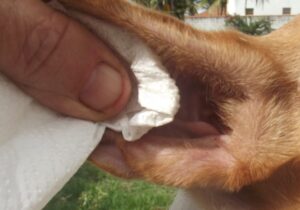
Before cleaning your dog’s ears, it’s vital to ensure that it is comfortable and relaxed. Here are a few steps you can take to prepare your dog for an ear cleaning:
1. Choose a calm, peaceful location: Find a peaceful location where you can clean your dog’s ears. This will help your dog feel more at ease and less anxious.
2. Gather all your supplies: Make sure you have everything you need, including ear cleaning solution, cotton balls or pads, a towel, and a flashlight (if desired).
3. Have a helper: It can be helpful to have a helper hold your dog or gently restrain them while you clean its ears. This will help your dog feel more secure and allow you to focus on the cleaning process.
4. Reward your dog: Consider rewarding your dog with treats or praise after the ear cleaning. This will help your dog associate ear cleaning with something positive.
5. Gently lift your dog’s ear flap: Gently lift your dog’s ear flap and expose the ear canal. This will allow you to see the inside of the ear and access it more easily.
6. Apply ear cleaning solution: Squeeze a small amount of ear cleaning solution onto a cotton ball or pad.
Gently wipe the inside of the ear canal: Use the cotton ball or pad to gently brush the inside, not inserting it too far into the ear.
It’s important to be gentle and patient when cleaning your dog‘s ears. If your dog is anxious or resistant, wait and try again later.
How do I safely clean the inside of my dog’s ear?
To safely clean the inside of your dog’s ear, follow these steps:
1. Make sure your dog is comfortable and relaxed: Encourage your dog to sit or lie in a comfortable position and use a calm, reassuring tone to communicate with them.
2. Gently lift the ear flap: Hold the base of your dog’s ear and gently lift the ear flap. This will expose the inside of the ear.
3. Apply ear cleaning solution: Squeeze a small amount of ear cleaning solution into the inside of your dog’s ear. Avoid inserting the nozzle deep into the ear canal, as this can cause discomfort or damage.
4. Gently massage the base of the ear: Use your fingers to gently massage the bottom of your dog‘s ear for about 30 seconds. This will help loosen any dirt or wax that may be present.
5. Wipe the inside of the ear: Use a cotton ball or pad to wipe the inside of your dog’s ear gently. Be sure to use a soft, lint-free cotton product to avoid leaving any fibers behind in the ear canal. Avoid inserting the cotton too far into the ear canal.
6. Repeat the process on the other ear: Repeat the process on the other ear, being careful to use a clean cotton ball or pad.
7. Dry your dog’s ears: Use a towel or cloth to gently dry your dog‘s ears after cleaning.
By following these steps, you can safely and effectively clean the inside of your dog’s ear. If you have any concerns about your dog’s ear health or if they show any signs of discomfort during the cleaning process, it’s a good idea to consult with your veterinarian. They can provide specific recommendations based on your dog‘s individual needs.
How do I safely clean the outside of my dog’s ear?
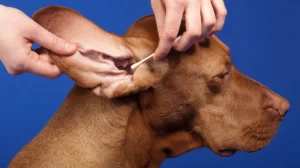
Cleaning the outside of your dog’s ear is vital to maintaining your dog’s overall health and hygiene. However, it is crucial to be cautious when cleaning your dog’s ear to avoid causing harm or discomfort.
To safely clean the outside of your dog’s ear, follow these steps:
1. Gather the necessary supplies
You will need a cotton ball or pad, a small bowl of warm water, and a veterinarian-approved ear-cleaning solution. Avoid using cotton swabs or inserting anything into the ear canal, as this can cause damage.
2. Restrain your dog
If your dog is prone to wriggling or is anxious about cleaning their ears, it may be necessary to restrain them gently to ensure its safety and yours.
3. Wet the cotton ball or pad
Dip the cotton ball or pad in the bowl of warm water and wring out any excess. Be sure not to use too hot water, as this can be uncomfortable for your dog.
4. Apply the cleaning solution
If you use an ear-cleaning solution, apply a small amount to the cotton ball or pad. Be sure to follow the instructions on the bottle, as some ear-cleaning solutions may need to be diluted before use.
5. Clean the ear
Gently wipe the outside of your dog’s ear with the damp cotton ball or pad. Avoid going too deep into the ear canal, as this can cause damage. If your dog‘s ear appears dirty or dirty, you may need to repeat this process a few times.
6. Dry the ear
Use a dry cotton ball or pad to pat the outside of your dog’s ear gently.
How do I know if my dog’s ears are dirty or infected?
A few signs may indicate that your dog’s ears are dirty or infected. If your dog’s ears are dirty, they may smell bad or appear coated in wax or debris. When you inspect your dog‘s ears, you may also see visible dirt or debris inside the ear canal.
If your dog’s ears are infected, they may be red and inflamed, and your dog may be scratching at them frequently. They may also be painful or tender to the touch, and your dog may shake their head or rub their ears on the ground.
Your dog may also have discharge from its ears, which may be yellow, green, or brown. If you notice these signs, you must take your dog to the vet as soon as possible to get proper treatment.
What are the symptoms of ear infections in dogs?
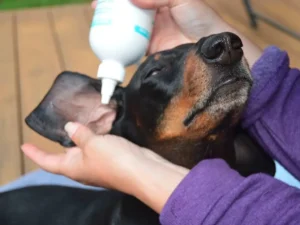
Ear infections are a common problem in dogs, and various factors, including wax buildup, allergies, or foreign objects in the ear, can cause them. Symptoms of ear infections in dogs may include:
1. Ear pain: Dogs with ear infections may show discomfort or pain when their ears are touched or when they shake their head.
2. Redness or swelling: The ear flap or ear canal may be red or swollen, especially if the infection is severe.
3. Discharge: Ear infections can cause a yellow, green, or brown discharge from the ear, which may have a strong odor.
4. Itching or scratching: Dogs with ear infections may constantly scratch or rub their ears to alleviate discomfort.
5. Changes in behavior: Dogs with ear infections may exhibit changes in behavior, such as difficulty hearing, lethargy, or irritability.
How do I treat ear infections in dogs?
Ear infections in dogs are common and can be caused by various factors, including allergies, foreign objects in the ear, and underlying medical conditions. Having your dog’s ear infection evaluated and treated by a veterinarian is essential, as untreated ear infections can lead to more severe health problems.
To treat an ear infection in a dog, your veterinarian may prescribe medication, such as antibiotics or anti-inflammatory drugs, to clear up the infection and reduce inflammation. They may also recommend cleaning your dog’s ears to remove any debris or discharge contributing to the infection.
It is essential to follow your veterinarian’s instructions for administering and completing the prescribed treatment to ensure that the infection is fully resolved. In addition, your veterinarian may recommend strategies to prevent future ear infections, such as avoiding specific triggers or using preventive ear drops.
Can I use ear cleaning solution on my dog’s ears?
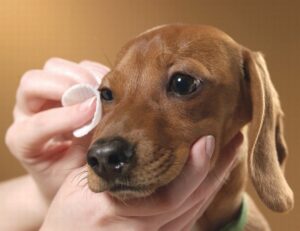
The ear cleaning solution is a specially formulated liquid designed to gently clean and deodorizes your dog’s ears. It can be an effective tool for maintaining your dog‘s ear health and preventing ear infections.
To use ear cleaning solution on your dog’s ears, follow these steps:
1. Make sure your dog is comfortable and relaxed: Encourage your dog to sit or lie in a comfortable position and use a calm, reassuring tone to communicate with them.
2. Gently lift the ear flap: Hold the base of your dog’s ear and gently lift the ear flap. This will expose the inside of the ear.
3. Apply ear cleaning solution: Squeeze a small amount of ear cleaning solution into your dog‘s ear. Avoid inserting the nozzle deep into the ear canal, as this can cause discomfort or damage.
4. Gently massage the base of the ear: Use your fingers to gently massage the bottom of your dog’s ear for about 30 seconds. This will help loosen any dirt or wax that may be present.
5. Wipe the inside of the ear: Use a cotton ball or pad to wipe the inside of your dog’s ear gently. Be sure to use a soft, lint-free cotton product to avoid leaving any fibers behind in the ear canal. Avoid inserting the cotton too far into the ear canal.
6. Repeat the process on the other ear: Repeat the process on the other ear, being careful to use a clean cotton ball or pad.
7. Dry your dog’s ears: Use a towel or cloth to gently dry your dog‘s ears after cleaning.
Can I use cotton balls or swabs to clean my dog’s ears?
Cleaning a dog’s ears can be an essential part of their grooming routine, as it helps to remove dirt, debris, and excess wax that can accumulate in the ear canal. Some pet owners choose to use cotton balls or cotton swabs for this purpose, but it’s essential to be careful when using these items.
Cotton balls can be effective for gently wiping away dirt and debris from the outer ear, but they may not be suitable for cleaning deeper inside the ear canal. Cotton swabs, also known as Q-tips, should be used cautiously, as they can easily go too far into the ear canal and cause injury. Cotton swabs can push wax and debris further into the ear if misused, leading to blockages and potential ear infections.
How do I prevent ear infections in my dog?

There are several steps you can take to prevent ear infections in your dog:
1. Keep your dog’s ears clean: Regular ear cleaning can help prevent ear infections by removing excess wax and dirt that can harbor bacteria or yeast. It’s essential to use a gentle, pH-balanced ear-cleaning solution and to follow the instructions provided by the manufacturer.
2. Monitor your dog’s ear health: Keep an eye on your dog‘s ears for signs of wax buildup, redness, swelling, or discharge. If you notice any of these signs, you must consult your veterinarian as soon as possible.
3. Avoid water in the ears: Water in the ears can create a breeding ground for bacteria and yeast, leading to ear infections. To prevent water from getting into your dog’s ears, you can use earplugs or a hood when you bathe your dog or when they swim.
4. Avoid inserting foreign objects into the ear canal: It’s important to avoid inserting foreign objects into your dog’s ear canal, as this can cause damage or irritation.
5. Keep your dog’s environment clean: A clean environment can help prevent ear infections by reducing the number of bacteria and yeast present. Be sure to regularly clean your dog’s bedding, toys, and other objects.
By following these steps, you can help prevent ear infections in your dog and maintain its overall ear health if you have any concerns about your dog’s ear health.
Can I clean my dog’s ears at home or do I need to go to the vet?
It is safe to clean your dog’s ears at home as long as you are careful and follow proper techniques. However, if your dog has any underlying ear problems or if you are unsure of how to properly clean your dog’s ears, it is always best to consult with a veterinarian. They will be able to provide you with specific instructions on how to properly care for your dog’s ears and determine if any underlying issues need to be addressed.
You will need an ear-cleaning solution and cotton balls or pads to clean your dog‘s ears at home. Start by gently wiping the outer ear with a cotton ball or pad to remove any dirt or debris. Avoid using cotton swabs, as these can easily damage the ear canal.
Next, fill the ear canal with an ear-cleaning solution and gently massage the base of the ear to help loosen any wax or debris.
Finally, wipe the inside of the ear with a cotton ball or pad to remove any excess solution or debris. Be sure to use a clean cotton ball or pad for each ear and be careful not to push the cotton too far into the ear canal. If you notice any redness, swelling, or discharge in your dog’s ears, or if your dog seems to be in pain or discomfort, it is vital to contact a veterinarian as soon as possible.
How do I know if my dog’s ears need professional cleaning?
A few signs may indicate that your dog’s ears need professional cleaning. These include:
1. Excessive ear wax or debris: If you notice a buildup of wax or debris in your dog’s ears, or if your dog’s ears have a strong, unpleasant smell, this may be a sign that their ears need cleaning.
2. Redness or swelling: If you notice redness or swelling in your dog‘s ears, or if your dog is scratching their ears excessively, this may be a sign of an ear infection or other issue that requires professional attention.
3. Discharge: If you notice a discharge coming from your dog’s ears or if their ears are crusty or scabbed, this may be a sign of an underlying issue that needs to be addressed by a veterinarian.
Conclusion
Cleaning a dog‘s ears is vital to maintaining its overall health and hygiene. Then aspects of how to clean dog’s ears, start by gently wiping the outer ear with a damp cloth to remove any dirt or debris.
Next, fill an ear-cleaning solution into the ear canal and gently massage the base of the ear to help loosen any wax or debris. Allow the solution to sit for a few minutes before gently wiping the inside of the ear with a cotton ball or cloth.
It is essential to be gentle and avoid inserting any objects into the ear canal as this can cause damage to the eardrum. If you are unsure about how to clean your dog‘s ears or if your dog has ear infections or other ear issues, it is best to consult a veterinarian for proper treatment.

